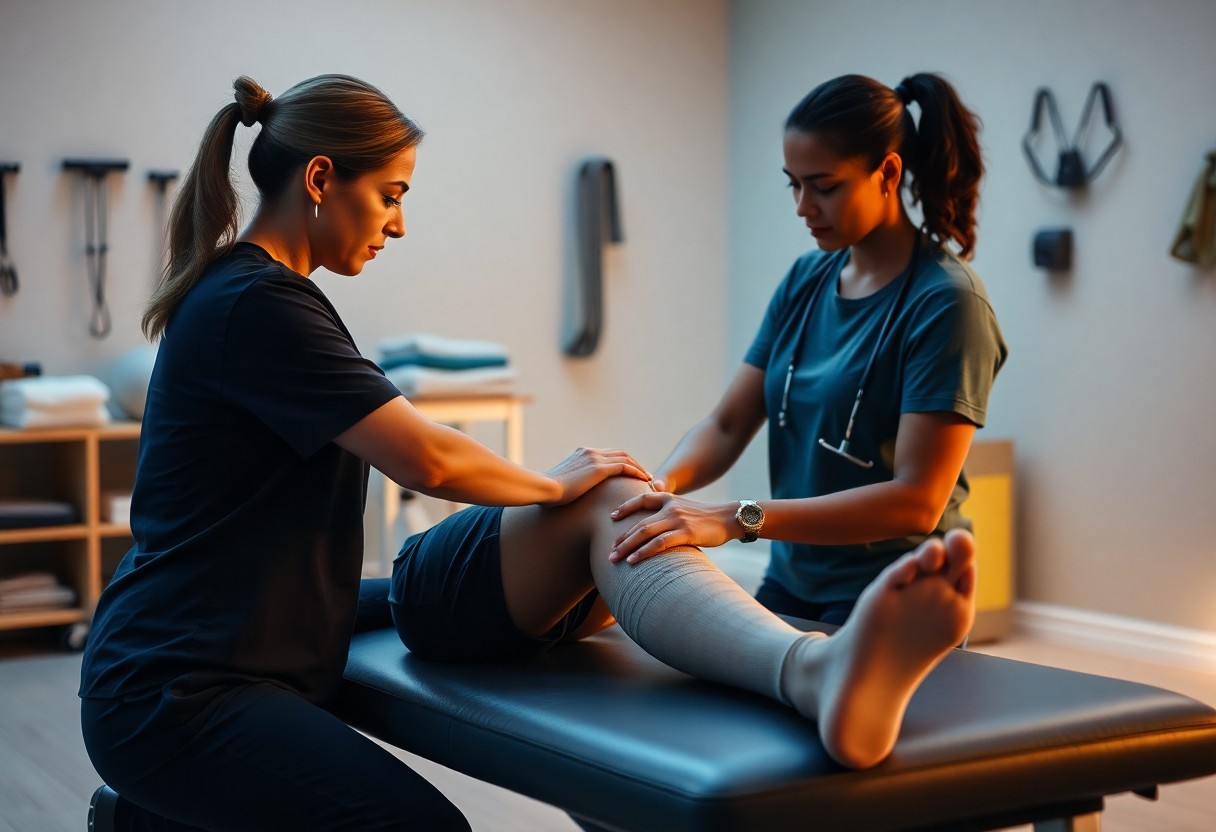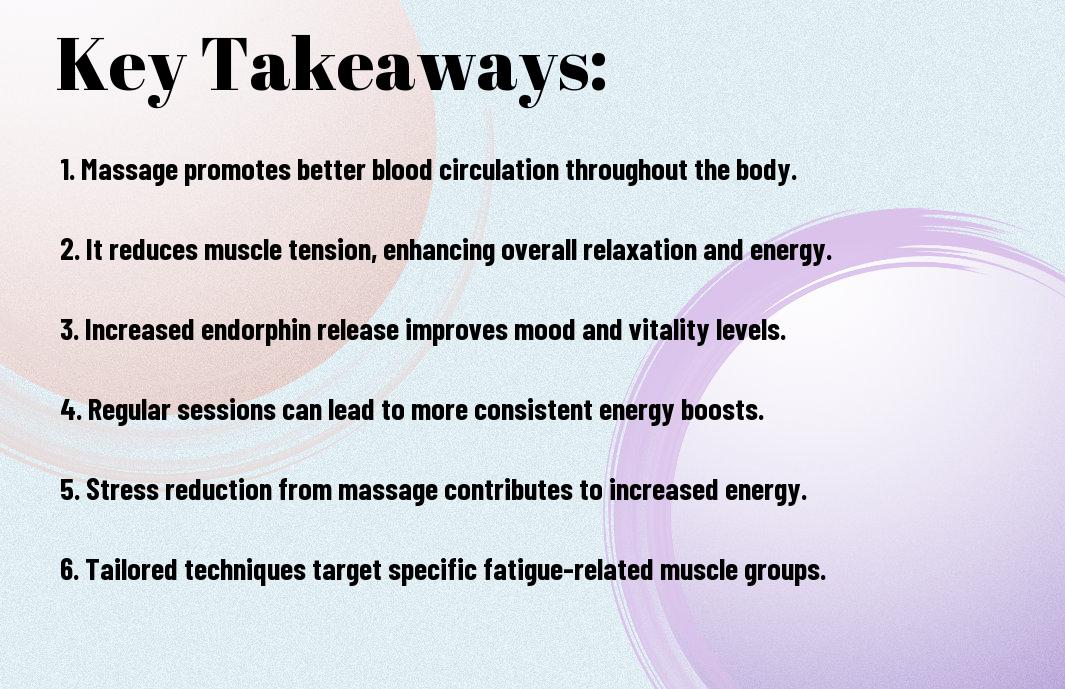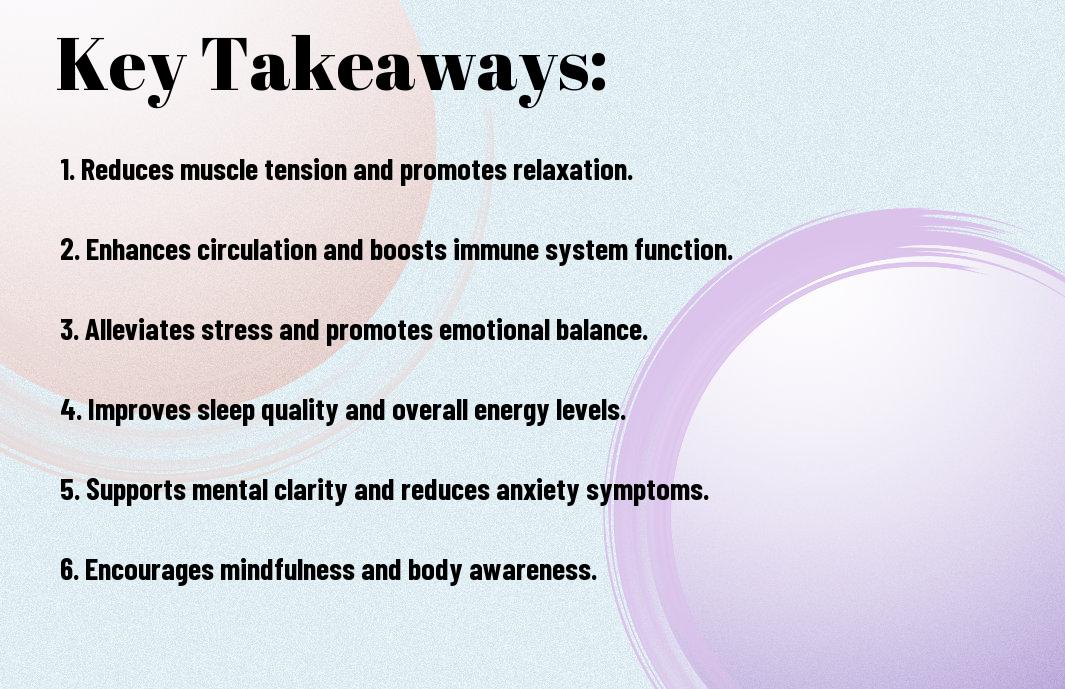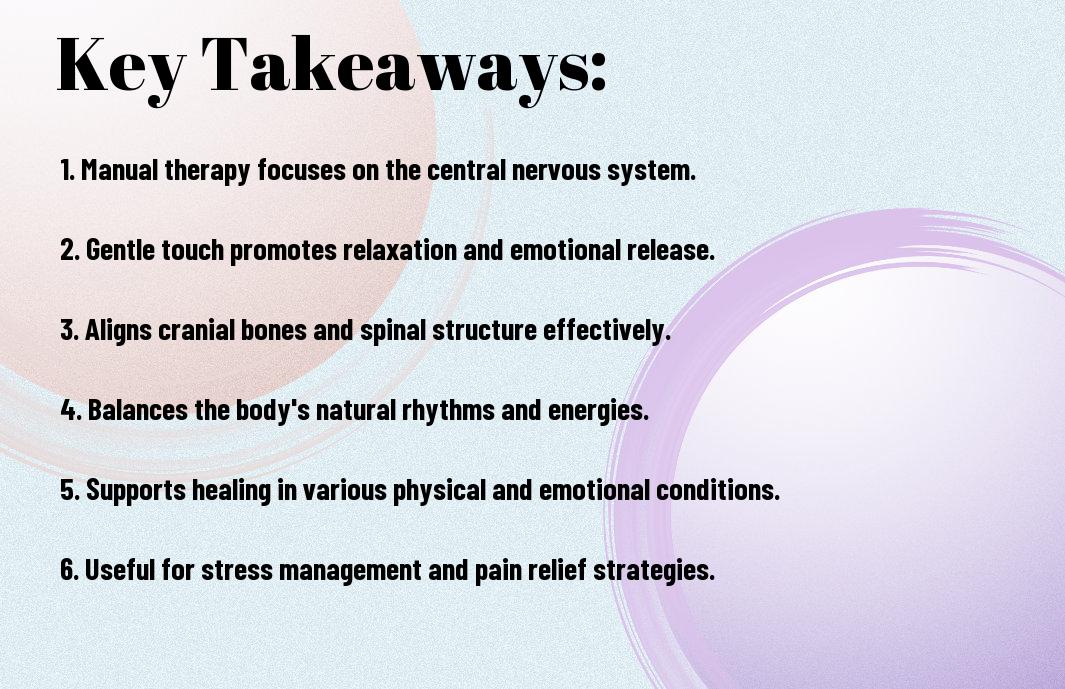Just imagine yourself on the path to recovery after an injury, and massage therapy can play a significant role in that process. By enhancing blood circulation and promoting relaxation, massage helps to alleviate pain and tension in your muscles, enabling your body’s natural healing mechanisms to function more effectively. As you explore the benefits of massage, you’ll discover how it can not only speed up your recovery but also improve your overall well-being. Understanding the role of massage can empower you to make informed choices in your rehabilitation journey.
Key Takeaways:
- Improved Blood Circulation: Massage enhances blood flow to the injured area, promoting faster healing by delivering necessary nutrients and oxygen needed for tissue repair.
- Pain Relief: Therapeutic massage can alleviate discomfort and reduce muscle tension, helping to manage pain associated with injuries and facilitating a more comfortable recovery process.
- Increased Range of Motion: Regular massage can help restore flexibility and mobility by loosening tight muscles and joint structures, aiding in a faster return to normal physical activities.
Understanding Injury Recovery
Before you can fully appreciate the significance of massage in injury recovery, it’s important to recognize the various stages of healing. Your body goes through a complex process that involves inflammation, tissue repair, and rehabilitation. Incorporating massage therapy can enhance this process and provide Help for your Sports Injury Rehabilitation by promoting blood circulation and reducing scar tissue formation.
The Healing Process
Along your journey to recovery, your body undergoes several phases, including inflammation, proliferation, and remodeling. Each phase plays a vital role in healing, and understanding these stages enables you to adopt appropriate strategies that complement the overall process.
Factors Influencing Recovery
To effectively navigate your recovery, it’s important to be aware of the factors that can impact healing. These include:
- Your age and overall health
- The nature and severity of the injury
- Your mindset and emotional state
- The quality of medical care you receive
Thou must take each of these into account to optimize your recovery journey.
Consequently, a comprehensive understanding of these influencing factors can significantly enhance your recovery experience. Acknowledging the importance of:
- Consistent follow-up care
- Physical therapy to maintain mobility
- Nutrition that supports tissue repair
- Your level of rest and sleep for recovery
Thou will be better equipped to manage your healing journey effectively.
The Benefits of Massage Therapy
Clearly, massage therapy offers numerous benefits that enhance your recovery process. By relieving tension in your muscles and improving flexibility, massage can significantly speed up healing and help you regain strength. Additionally, it aids in reducing scar tissue formation while promoting relaxation and overall well-being, making it an invaluable component of your injury recovery journey.
Pain Relief
Above all, one of the most immediate benefits of massage therapy is pain relief. By applying targeted pressure to your injured areas, massage helps to reduce muscle tension and alleviate discomfort, allowing you to move more freely and engage in daily activities with less hindrance.
Improved Blood Circulation
Therapy also plays an crucial role in improving blood circulation throughout your body. Enhanced blood flow delivers more oxygen and nutrients to injured tissues, promoting faster healing and recovery. Additionally, increased circulation flushes out toxins that can contribute to pain and inflammation, ensuring that your body is better equipped to heal itself.
Indeed, improved blood circulation through massage therapy not only aids in recovery but also improves overall health. As circulation enhances, your muscles receive the necessary nutrients to repair themselves, and injury-related swelling can decrease. This process minimizes pain and discomfort, enabling you to regain mobility and strength more quickly. Prioritizing massage in your recovery regimen can lead to a more effective healing journey, making you feel revitalized and ready to resume your activities.
Types of Massage for Recovery
Now, it’s important to understand the various types of massage that can aid in your recovery process. Each type targets different needs and can be beneficial depending on your injury:
| Sports Massage | Aimed at athletes to prevent and treat injuries. |
| Deep Tissue Massage | Focuses on realigning deeper layers of muscles and connective tissue. |
| Swedish Massage | Uses long strokes and kneading to relax the body. |
| Trigger Point Therapy | Focuses on specific tight areas in the muscle. |
| Myofascial Release | Targets the fascia to relieve tension and pain. |
Perceiving the differences among these types can help you select the right massage for your individual needs.
Sports Massage
Between the demands of physical activity and the recovery process, sports massage offers specialized techniques tailored to prevent injuries, enhance performance, and promote recovery. This form of massage typically involves a combination of firm pressure and targeted manipulation to relax tight muscles and improve blood circulation. Whether you’re an athlete or a weekend warrior, sports massage can play a vital role in keeping your body resilient.
Deep Tissue Massage
After intense training sessions, you may find that deep tissue massage can provide relief for aches and pains. This technique involves applying pressure to relieve tension in deeper layers of your muscles and connective tissues. Through calculated strokes and friction, deep tissue massage helps break up adhesions and enhance mobility, making it an effective choice for those recovering from injuries.
Indeed, deep tissue massage investigates deeper into the muscle structure, making it particularly effective for chronic pain or injury recovery. By targeting specific muscle groups that may be tight or inflamed, you can experience improved flexibility and reduced pain in the affected areas. This technique often encourages faster recovery times by promoting better blood flow and releasing toxins stored in the muscles. Overall, incorporating deep tissue massage into your recovery regimen can significantly enhance your healing process and improve your overall performance.
Timing and Frequency of Massage
Not all massage treatments are created equal, and knowing when to schedule them can significantly influence your recovery. Ideally, you should tailor the timing and frequency of your massage therapy based on the nature and severity of your injury, as well as your personal healing process. It is recommended to consult with a healthcare professional to create a plan that effectively supports your recovery journey.
Post-Injury Treatment
To maximize healing, consider starting massage therapy shortly after your injury occurs. Early intervention can help reduce swelling, improve circulation, and alleviate muscle tension. Aim for regular sessions during the first few weeks, as this focused care supports your body’s natural healing mechanisms.
Ongoing Maintenance
Massage therapy can play an important role in your long-term injury recovery plan. By incorporating regular sessions into your routine, you can maintain flexibility, reduce the risk of re-injury, and improve overall well-being.
Post-injury, maintaining a consistent massage schedule is vital for optimal recovery and physical health. Regular sessions help to manage scar tissue formation and enhance blood flow to affected areas. This ongoing maintenance not only keeps your body in balance but also empowers you to actively participate in your recovery, ensuring you remain agile and pain-free in your daily activities.
Risks and Considerations
Your decision to incorporate massage into your injury recovery should come with an awareness of potential risks and considerations. Massage can sometimes aggravate certain injuries, particularly those involving inflammation or open wounds. It’s crucial to evaluate your condition carefully and ensure that the techniques used by a therapist align with your healing process. Always prioritize your well-being by being informed about the limitations of massage therapy.
When to Avoid Massage
After sustaining an acute injury or experiencing severe pain, it’s advisable to avoid massage until a thorough evaluation is completed. Conditions such as fractures, sprains, or infections often require rest and initial medical intervention rather than hands-on techniques. Listening to your body and seeking professional guidance can help ensure that you don’t exacerbate your condition.
Consulting with Healthcare Professionals
Against the backdrop of injury recovery, it’s vital to consult with healthcare professionals before starting any massage therapy. Your physician or physical therapist can provide insights into whether massage is safe and beneficial for your specific situation. Their guidance can help tailor your recovery plan, ensuring you leverage the advantages of massage therapy without risking further injury.
Avoid bypassing this important step in your recovery journey. Healthcare professionals possess the knowledge to evaluate your injuries and recommend appropriate treatments, including whether massage therapy is suitable. By collaborating with them, you can ensure a safer, more effective recovery process that addresses your individual needs and promotes overall well-being.
Integrating Massage into Recovery Plans
Keep in mind that integrating massage therapy into your injury recovery plan can significantly enhance your healing process. By working with a qualified practitioner, you can ensure that massage is tailored to your specific needs and injury type. Regular sessions can help improve circulation, reduce muscle tension, and promote relaxation, which are all beneficial for recovery. Combining massage with other complementary treatments can provide a comprehensive approach, leading to a more effective recovery journey.
Combining with Other Therapies
For optimal recovery, it’s beneficial to combine massage therapy with other therapeutic practices, such as physical therapy or chiropractic care. This multifaceted approach can address various aspects of your injury, promoting better overall healing and restoring function more effectively. Different therapies can complement each other, enabling a more holistic recovery experience tailored to your individual needs.
Personalized Recovery Strategies
Therapies should never be one-size-fits-all. Personalized recovery strategies are imperative in ensuring that your treatment plan aligns with your specific injury and lifestyle. Collaborating with healthcare professionals allows you to create a comprehensive recovery plan that includes massage tailored to your unique needs, whether that means focusing on specific muscle groups, adjusting pressure techniques, or integrating other forms of therapy.
Indeed, personalized recovery strategies not only enhance your healing process but also empower you to take an active role in your recovery. By assessing your progress and adapting your treatment plan as necessary, you can ensure that your massage therapy effectively complements your overall recovery goals. Engaging with professionals who understand your specific injury enables you to receive customized care that can lead to faster and more successful recovery outcomes.
Summing up
Hence, incorporating massage into your injury recovery routine can significantly enhance your healing process. It aids in alleviating pain, reducing muscle tension, and improving circulation, which are important for restoring your body’s function. By promoting relaxation and flexibility, massage therapy not only helps in recovering from injuries but also prepares your body for future physical activities. Ultimately, prioritizing this therapeutic approach can lead to a more effective recovery journey and a faster return to your normal activities.
FAQ
Q: How does massage therapy aid in muscle recovery after an injury?
A: Massage therapy promotes increased blood circulation, which helps deliver crucial nutrients and oxygen to the injured muscles. This enhanced blood flow aids in flushing out metabolic waste products, reducing muscle tension, and alleviating soreness. Additionally, massage can help break down scar tissue and adhesions, improving flexibility and range of motion during the recovery process.
Q: What types of massage techniques are most effective for injury recovery?
A: Several massage techniques can support injury recovery, including deep tissue massage, sports massage, and myofascial release. Deep tissue massage focuses on realigning deeper layers of muscle and connective tissue, sports massage helps prevent and treat sports-related injuries, and myofascial release targets the fascia to release tension and improve movement. Tailoring the technique to the type and severity of the injury is crucial for optimal results.
Q: When should massage therapy be introduced during the injury recovery process?
A: The timing for introducing massage therapy depends on the nature and severity of the injury. Generally, it is advisable to wait until any acute inflammation and swelling have subsided before starting massage sessions. For minor injuries, massage can often begin within a few days, while more serious injuries may require a longer period before massage is appropriate. Consulting with a healthcare professional is recommended to determine the best timing for individual cases.
Q: Are there any potential risks associated with using massage for injury recovery?
A: While massage therapy can be beneficial, there are some risks, especially if performed too early in the recovery process or by an untrained practitioner. It can potentially exacerbate inflammation or cause additional discomfort if applied incorrectly. It’s vital to seek treatment from qualified and experienced massage therapists who have knowledge of injury recovery, and to communicate openly about any pain or discomfort experienced during sessions.
Q: How often should massage therapy be received during the recovery phase?
A: The frequency of massage therapy during recovery can vary based on the individual’s specific injury and overall healing progress. Generally, sessions may be scheduled once or twice a week, with adjustments based on the individual’s response to treatment. Engaging in a thorough assessment and open dialogue with the massage therapist will help determine the best regimen to promote healing effectively.










